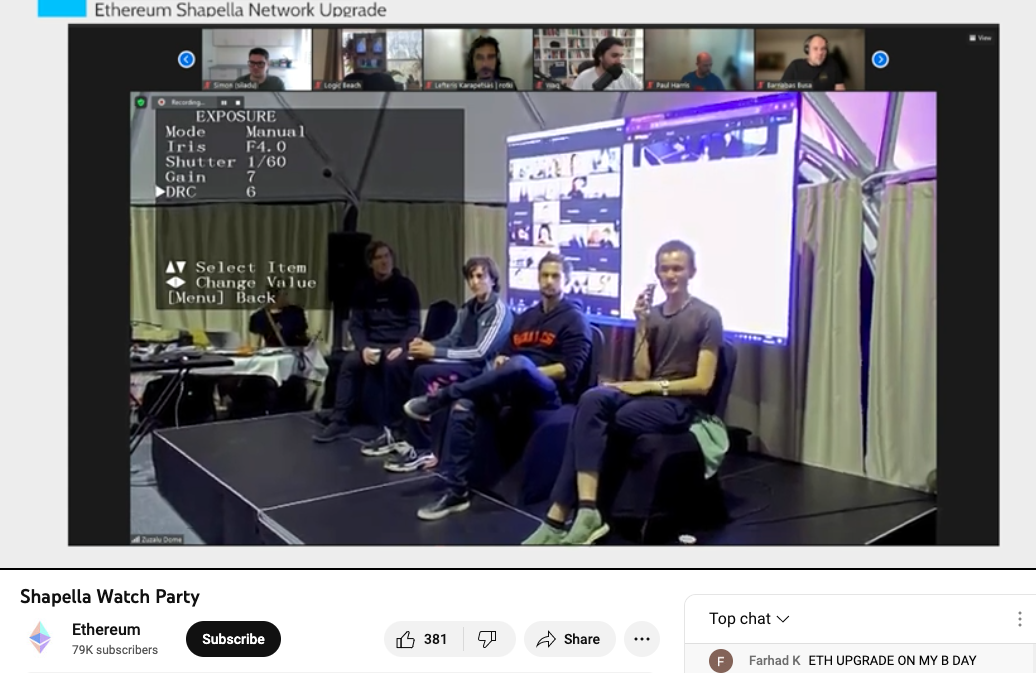After months of anticipation, Ethereum’s Shanghai and Capella forks, also known as the Shapella upgrade, have finally gone live. The upgrade, triggered at 22:27 UTC, and finalized at about 22:42 UTC, has introduced vital functionality to the Ethereum network, allowing those who staked ETH to withdraw their cryptocurrency from the Beacon Chain for the first time. The Shapella upgrade represents a significant step in Ethereum’s development as it transitions to the Proof of Stake consensus algorithm from Proof of Work.
The Shapella upgrade marks the first major change to the Ethereum network since The Merge transitioned the network to Proof of Stake consensus from Proof of Work, reducing Ethereum’s energy consumption by 99.9% and new ETH issuance by more than 90%. Ethereum stakers now face a crucial decision about what to do with their accumulated rewards and initial position of 32 Ether.
The upgrade was released on the mainnet at epoch 194048, and the developers will be monitoring for any potential issues with the upgrade’s completion. With the introduction of the Shapella upgrades, the Ethereum network has completed the Proof-of-Stake transition cycle, which has the potential to unlock previously inaccessible funds and impact the ecosystem.
What is the Shanghai & Capella Upgrade?
The Shapella upgrade name is a combination of the two words Shanghai and Capella. The upgrade gets its name from the city of Shanghai, which hosted the Devcon 2 conference, and Capella, the brightest star in the northern constellation of Auriga. On the execution client side, the fork is called Shanghai, while the consensus layer client side upgrade is named Capella.
The upgrade consists of a few Ethereum Improvement Proposals (EIPs), although most of the focus is on one particular. Planned changes to the blockchain’s execution layer are collectively known as “Shanghai,” while changes to the consensus layer are known as Capella.
The EIPs in question are:
- EIP-3651: Warm COINBASE
- EIP-3855: PUSH0 instruction
- EIP-3860: Limit and meter initcode
- EIP-4895: Beacon chain push withdrawals as operations
- EIP-6049: Deprecate SELFDESTRUCT
The most significant new feature is the ability for validators to withdraw their staked ETH from the Beacon chain. In addition, validators have the ability to stop running their node or stop validating. They can exit the Beacon network, unlock their 32 ETH and take any earned rewards. Roughly half an hour after the Shanghai upgrade was activated, some 285 withdrawals in epoch 194,408 had been processed, for about 5,413 ETH ($10 million worth), according to beaconcha.in.
Prior to the Shapella upgrade, validators on the Ethereum network could only stake their Ethereum and receive rewards. The process was one-sided, as validators could deposit their stakes but were unable to withdraw them to the execution layer. However, with the implementation of the Shapella upgrade, validators now have the ability to withdraw their staked ETH to the execution layer with ease.
In short, the upgrade completes the process of unlocking staked Ether. It is part of finalizing The Merge which is a major Ethereum update that took place on September 15, 2022. The upgrade completes the validator lifecycle.
Types of Withdrawals
Validators in the Ethereum network can initiate two types of withdrawals, partial and full withdrawals. With partial withdrawals, validators can withdraw any ETH over the required 32 ETH balance, which often comes from staking rewards. This type of withdrawal allows access to staking rewards while maintaining the overall security of the Ethereum network since the validator remains a validator.
In contrast, full withdrawals enable validators to exit the beacon chain and unlock both their 32 ETH principle and earned rewards. However, neither partial nor full withdrawals happen automatically and must be initiated manually by the validator.
It’s important to note that Ethereum developers have made staking an easy process while withdrawing has been made difficult. To withdraw, validators must update their credential prefixes to 0x01 instead of the favored 0x00 prefix. Additionally, validators must manually set their withdrawal address, which can only be done once, and any mistakes could permanently limit the withdrawal possibility.
Validators must wait in a lengthy queue to become eligible for withdrawal, and withdrawals will only occur when the validator has a withdrawal address set. The Shanghai upgrade will limit the amount of ETH available for withdrawal, with less than 60,000 ETH eligible for withdrawal per day. As a result, it would take over 18 months to fully withdraw and sell the full amount of staked ETH, preventing the currently staked ETH from being dumped on the market all at once.
Other Ethereum Improvements
The proposed improvements in the Shanghai upgrade for Ethereum are focused on decreasing gas fees during times of high network congestion and activity. One of these improvements is EIP-3651 (Warm COINBASE), which aims to lower gas costs associated through accessing the COINBASE address at the initial access list at the beginning of any transaction. It is important to note that in this context, COINBASE refers to a solution that developers use to receive new tokens, and not the popular US-based exchange. The motivation behind this improvement is to empower layer-1 transactions. Traders will be able to initiate a transaction with a zero fee and tip the COINBASE.
Another proposal, EIP-3855 (PUSH0 instruction), introduces a new instruction that pushes the constant value 0 onto the stack. This is designed to reduce gas costs for developers because there will be less bytes to deploy to the EVM. EIP-3860 and EIP-6049 are also aimed at reducing fees in other instances.
The Shanghai (Shapella) upgrade is a significant milestone for Ethereum on its path toward security, decentralization, and scalability. It alleviates a significant burden for validators and provides a clearer outlook on the network state, once validators are able to freely remove their stake at will.
Impact on the Market
One of the biggest uncertainties associated with the Shapella upgrade is how it will impact the overall Ethereum ecosystem. Some investors are concerned that the ability to unstake ETH could lead to a sell-off of the cryptocurrency and a drop in its value. Others worry that the upgrade could create a situation where there is too much ETH in circulation, which could also negatively impact the cryptocurrency’s value
Investors are concerned about the possibility of stakers dumping their holdings on the market following the Shapella upgrade, which allows stakers to withdraw their staked ETH and rewards earned so far. Currently, approximately 15% of the total ETH supply is staked on the network, and the market could face up to $33 billion worth of selling pressure as a result of the upgrade.
“Most ETH holders are underwater at the current market price, and most of these holders are committed to Ethereum long-term. We think the majority of withdrawn ETH may be restaked to new validators to compound rewards,” said Alexander Esin, CEO of staking firm P2P.org, about the potential market impact.
However, it should be noted that there are limitations to the amount of staking withdrawals that can take place per block, and it would take approximately 60 days for 20% of validators on the network to unstake their ETH. In addition, they would have to wait another 27 hours for the withdrawal to complete.
Selling Pressure Relief
An alternative way to look at the rate of validators leaving the network is to take into account that only 8 validators can exist per epoch, which equates to 1,800 validators daily. This means that the potential selling pressure may not materialize all at once and may be spread out over time.
Partial withdrawals are taking center stage in the Ethereum network. Major players such as Kraken, Lido, and Coinbase have requested partial withdrawals, which will take up most of the initial five-day withdrawal period.
To accommodate these requests, Ethereum will process up to 16 partial withdrawals per ~12 slots, with approximately 7,200 slots per day. This allows for around 110,000 validators to initiate partial withdrawals per day.
With approximately half a million validators on the Ethereum network, the process of partial withdrawals will take about five days. During this time, over $350 million dollars worth of withdrawals can be expected per day.
Partial withdrawals are a means of accommodating immediate requests for staked ETH and allow validators to access their rewards while still remaining active on the network. It is important to note that both partial and full withdrawals must be initiated manually by the validator and do not happen automatically.
Several validators may opt to keep their staked ETH, particularly those who have long-term investment plans. Some might prefer not to sell at a loss and instead use their staking rewards to create additional validators and accumulate more ETH, allowing them to withstand the present market conditions without focusing on price appreciation.
The network is now processing withdrawal requests but the price of ETH remained largely flat at the time the Shanghai hard fork was triggered, while about 4000 people tuned into a Shapella Mainnet Watch Party hosted by Ethereum Cat Herders.
Comments from Vitalik Buterin

Vitalik Buterin, Ethereum Inventor and Co-Founder, explained that scaling – making transactions faster and cheaper – will be the next issue that the blockchain tackles after Shanghai.
If we don’t fix scaling before the next bull run, we know people are going to be stuck paying $500 transactions. If, on the other hand, we don’t have Verkle Trees before the next bull run, well, things might suck, but you know, it’s a much smaller problem than, you know, $500 transactions, right?
Vitalik Buterin
Conclusion
The Shapella upgrade marks a significant milestone for the Ethereum network, bringing important functionality to the blockchain and enabling validators to withdraw their staked ETH for the first time.
While the upgrade presents exciting opportunities, there are also challenges and potential risks associated with the implementation, including concerns about potential selling pressure on the ETH market and uncertainties around the impact of the upgrade.
Despite these challenges, the Ethereum community remains optimistic about the future of the network and the potential benefits that the Shapella upgrade brings. As the Ethereum ecosystem continues to evolve and grow, it will be interesting to see how this upgrade and future upgrades shape the network’s path toward greater scalability, security, and decentralization.





